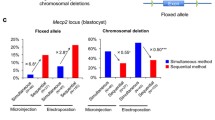Abstract
Generation of conditional knockout mice using the Cre-loxP system is essential for the analysis of gene functions. The use of CRISPR-Cas9 in combination with two sets of guide RNAs and single-stranded oligonucleotides including loxP sites enables simultaneous insertion of two loxP sequences. Unfortunately, this method induces double-strand breaks at two sites in the same chromosome, which causes an undesirable large chromosomal deletion and reduces the flanked loxP (flox) rate. To overcome this problem, we have developed a method that sequentially introduces each loxP sequence by electroporation at the one- and two-cell embryonic stages, respectively. This sequential electroporation method improves the floxing efficiency compared with the conventional simultaneous method, leading to a high yield of offspring with floxed alleles.
Access this chapter
Tax calculation will be finalised at checkout
Purchases are for personal use only
Similar content being viewed by others
References
Dickinson ME, Flenniken AM, Ji X, Teboul L, Wong MD, White JK, Meehan TF, Weninger WJ, Westerberg H, Adissu H et al (2016) High-throughput discovery of novel developmental phenotypes. Nature 537:508–514
Sauer B, Henderson N (1988) Site-specific DNA recombination in mammalian cells by the Cre recombinase of bacteriophage P1. Proc Natl Acad Sci U S A 85:5166–5170
Jinek M, Chylinski K, Fonfara I, Hauer M, Doudna JA, Charpentier E (2012) A programmable dual-RNA-guided DNA endonuclease in adaptive bacterial immunity. Science 337:816–821
Wang H, Yang H, Shivalila CS, Dawlaty MM, Cheng AW, Zhang F, Jaenisch R (2013) One-step generation of mice carrying mutations in multiple genes by CRISPR/Cas-mediated genome engineering. Cell 153:910–918
Ran FA, Hsu PD, Lin CY, Gootenberg JS, Konermann S, Trevino AE, Scott DA, Inoue A, Matoba S, Zhang Y et al (2013) Double nicking by RNA-guided CRISPR Cas9 for enhanced genome editing specificity. Cell 154:1380–1389
Yang H, Wang H, Shivalila CS, Cheng AW, Shi L, Jaenisch R (2013) One-step generation of mice carrying reporter and conditional alleles by CRISPR/Cas-mediated genome engineering. Cell 154:1370–1379
Bishop KA, Harrington A, Kouranova E, Weinstein EJ, Rosen CJ, Cui X, Liaw L (2016) CRISPR/Cas9-mediated insertion of loxP sites in the mouse Dock7 gene provides an effective alternative to use of targeted embryonic stem cells. G3 (Bethesda) 6:2051–2061
Nakagawa Y, Oikawa F, Mizuno S, Ohno H, Yagishita Y, Satoh A, Osaki Y, Takei K, Kikuchi T, Han SI et al (2016) Hyperlipidemia and hepatitis in liver-specific CREB3L3 knockout mice generated using a one-step CRISPR/Cas9 system. Sci Rep 6:27857
Ma X, Chen C, Veevers J, Zhou X, Ross RS, Feng W, Chen J (2017) CRISPR/Cas9-mediated gene manipulation to create single-amino-acid-substituted and floxed mice with a cloning-free method. Sci Rep 7:42244
Horii T, Morita S, Kimura M, Terawaki N, Shibutani M, Hatada I (2017) Efficient generation of conditional knockout mice via sequential introduction of lox sites. Sci Rep 7:7891
Gurumurthy CB, O’Brien AR, Quadros RM, Adams J Jr, Alcaide P, Ayabe S, Ballard J, Batra SK, Beauchamp MC, Becker KA et al (2019) Reproducibility of CRISPR-Cas9 methods for generation of conditional mouse alleles: a multi-center evaluation. Genome Biol 20:171
Horii T, Kobayashi R, Kimura M, Morita S, Hatada I (2020) Calcium-free and cytochalasin B treatment inhibits blastomere fusion in 2-cell stage embryos for the generation of floxed mice via sequential electroporation. Cells 9:1088
Horii T, Yamamoto M, Morita S, Kimura M, Nagao Y, Hatada I (2015) p53 suppresses tetraploid development in mice. Sci Rep 5:8907
Acknowledgments
We thank Ms. Eriko Suetomo for proofreading the text about gRNA selection. This work was supported by the Basic Science and Platform Technology Program for Innovative Biological Medicine from the Ministry of Education, Culture, Sports, Science, and Technology, Japan (MEXT); the Practical Research Project for Rare/Intractable Diseases from AMED; and the Research Support Project for Life Science and Drug Discovery (Basis for Supporting Innovative Drug Discovery and Life Science Research (BINDS)) from AMED under Grant Number JP22ama121049.
Author information
Authors and Affiliations
Corresponding authors
Editor information
Editors and Affiliations
Rights and permissions
Copyright information
© 2023 The Author(s), under exclusive license to Springer Science+Business Media, LLC, part of Springer Nature
About this protocol
Cite this protocol
Horii, T., Kobayashi, R., Hatada, I. (2023). Generation of Floxed Mice by Sequential Electroporation. In: Hatada, I. (eds) Genome Editing in Animals. Methods in Molecular Biology, vol 2637. Humana, New York, NY. https://doi.org/10.1007/978-1-0716-3016-7_11
Download citation
DOI: https://doi.org/10.1007/978-1-0716-3016-7_11
Published:
Publisher Name: Humana, New York, NY
Print ISBN: 978-1-0716-3015-0
Online ISBN: 978-1-0716-3016-7
eBook Packages: Springer Protocols




